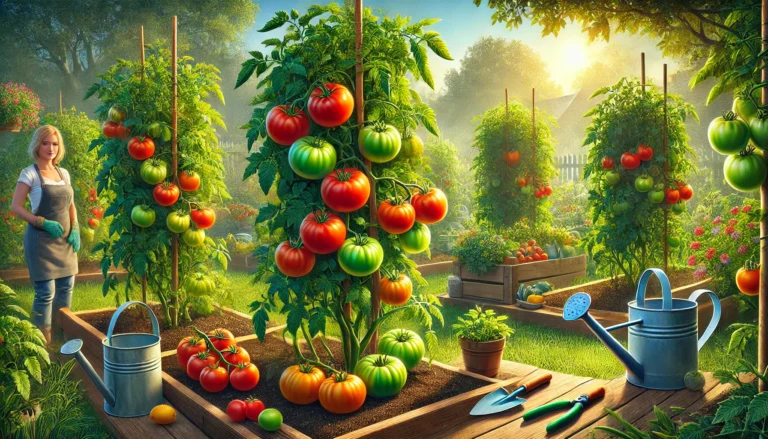As a professional copywriting journalist, I understand the importance of timing when planting tomatoes. In this article, I will provide a comprehensive tomato planting guide specific to New Hampshire. Whether you’re a seasoned gardener or just starting, this guide will help you successfully cultivate delicious tomatoes in the Granite State.
In This Article
When To Plant Tomatoes In New Hampshire?
Key Takeaways
- The best time to plant tomatoes in New Hampshire is after the last frost date, typically in late May or early June.
- Understanding New Hampshire’s growing season is crucial for determining the optimal time to start tomato seeds and plant transplants.
- Choosing suitable tomato varieties for the region’s climate and growing conditions is an essential factor for success.
- Proper soil preparation and planting techniques are essential for healthy tomato growth.
- Ongoing care and maintenance, including watering and pest/disease management, are crucial for maximizing tomato yields in New Hampshire.
Understanding New Hampshire’s Growing Season
When planting tomatoes in New Hampshire, it’s essential to understand the region’s growing season. The average last frost date in the state varies by location but generally falls between late April and mid-May. This means that it’s best to wait until after the last frost to plant tomatoes.
However, it’s also essential to consider the average temperatures and frost risk in your specific location. The best time to plant tomatoes in New Hampshire is in late May or early June when the soil has warmed up, and the risk of frost has passed.
When should you start tomato seeds in New Hampshire?
If you plan on starting tomato seeds indoors, it’s important to time them correctly to ensure they are ready to be transplanted into your garden at the optimal time. To do this, count back 6-8 weeks from your preferred planting date to determine when to start your tomato seeds indoors.
Remember that tomato seeds typically germinate best at temperatures between 70-80°F, so be sure to provide a warm and well-lit environment for your seedlings.
Recommended Tomato Planting Dates in New Hampshire
| Location | Recommended Planting Dates |
|---|---|
| Coastal Region (Portsmouth, etc.) | May 25 – June 5 |
| Inland Region (Manchester, etc.) | June 1 – June 10 |
| Northern Region (Conway, etc.) | June 5 – June 15 |
These recommended planting dates are based on average temperatures and frost risk in each region, but it’s important to note that weather patterns can vary from year to year. Be sure to monitor the forecast and adjust your planting schedule as needed.
Choosing the Right Tomato Varieties
When growing tomatoes in New Hampshire, selecting a suitable variety is key to a successful harvest. The state’s excellent and short growing season and occasional extreme weather conditions can challenge tomato cultivation. However, carefully selecting and planning allows gardeners to enjoy a bountiful tomato season.
One of the critical factors to consider when choosing tomato varieties for New Hampshire is their ability to withstand cool temperatures. Look for “early” or “cold-hardy” tomatoes, which can tolerate cooler weather and have a shorter time to maturity. Examples of such varieties include Glacier, Stupice, and Sub-Arctic Plenty.
Disease-resistant varieties are also an excellent choice for New Hampshire gardeners, as they can help mitigate common tomato diseases such as verticillium wilt, blight, and mosaic virus. Popular disease-resistant tomato varieties include Mountain Merit, Iron Lady, and Defiant.
If you prefer heirloom tomatoes, there are also some suitable options for New Hampshire’s growing conditions. Varieties such as Black Krim, Brandywine, and Cherokee Purple have proven to perform well in the region’s climate.
Remember to consider your specific location and growing conditions when selecting tomato varieties. Some varieties may perform better in certain parts of the state than others. In general, it’s a good idea to choose a variety that is adapted to cooler and shorter growing seasons.
Preparing the Soil and Planting Tomatoes
Proper soil preparation is essential for successful tomato cultivation in New Hampshire. Before planting, test the soil pH and nutrient levels. Tomatoes prefer slightly acidic soil with a pH between 6.0 and 6.8. Amend the soil as needed with compost or fertilizer to ensure adequate nitrogen, phosphorus, and potassium levels.
When planting tomatoes, choose a site that receives at least six hours of sunlight daily and has well-draining soil. Plant tomato seedlings once the soil temperature reaches at least 60°F, typically in New Hampshire in late May or early June. Dig a hole slightly more profound than the root ball of the seedling and space plants 24 to 36 inches apart.
| Tip: | Plant tomatoes deep, burying the lower third of the stem to encourage strong root growth. |
|---|
Support tomato plants, such as cages or stakes, to keep them upright and prevent fruit from touching the ground. Water tomato plants deeply once a week or more frequently during periods of drought. Avoid getting water on the leaves, as this can increase the disease risk.
Throughout the growing season, monitor tomato plants for signs of pests or disease. Common issues in New Hampshire include early blight, septoria leaf spot, and tomato hornworms. Remove any infected or infested foliage and treat it with an appropriate pesticide or fungicide.
As tomato plants grow, prune them by removing suckers — the small shoots that emerge from the joint where a branch meets the stem. This will encourage the plant to put energy into producing fruit rather than foliage. Additionally, pinching off the growing tip of the main stem once it has reached the desired height can help focus the plant’s energy on ripening existing fruit.
Following these tips for preparing the soil and planting tomatoes in New Hampshire, you’ll be on your way to a successful harvest of juicy, delicious tomatoes.
Maintaining and Caring for Tomato Plants
Once your tomato plants are in the ground, it’s essential to maintain and care for them properly to ensure a bountiful harvest. The following are some tips for maintaining and caring for your tomato plants in New Hampshire:
Watering
Tomatoes need consistent watering to thrive, especially during hot months. Aim to give your plants one to two inches of water each week, making sure to water deeply at the root level to encourage strong root growth. Avoid overhead watering, which can increase the risk of disease and fungal infections. Mulching around the base of the plants can help conserve moisture and regulate soil temperature.
Fertilizing
Fertilizing provides essential nutrients that help your tomato plants grow and produce fruit. Start by amending the soil with plenty of organic matter before planting, as this will slowly release nutrients over time. As the plants grow, you can supplement with regular balanced fertilizer applications, such as a 10-10-10 mix. Avoid over-fertilizing, as this can lead to excessive growth at the expense of fruit production.
Pests and Diseases
In New Hampshire, common tomato pests include hornworms, aphids, and flea beetles. Look for signs of infestation, such as chewed leaves or stunted growth, and use an appropriate insecticide or organic pest control method to manage the problem.
Also, monitor your plants for signs of disease, such as early or late blight. If detected, remove infected leaves or plants and treat the remaining plants with an appropriate fungicide.
Pruning
Pruning can help your tomato plants stay healthy and productive. Remove any suckers that appear between the main stem and the branches, as these can sap energy from the plant and reduce fruit production. Additionally, remove any lower leaves touching the soil to prevent disease risk.
Maximizing Yield
To maximize your tomato yield, try these tips:
- Support your plants with stakes, cages, or trellises to prevent sprawling and increase air circulation
- Harvest tomatoes when they’re firm and fully colored
- Store ripe tomatoes in a cool, dry place away from direct sunlight
- Rotate your crop each year to prevent disease buildup in the soil.
By following these tips, you’ll be well on your way to growing healthy, productive tomato plants in New Hampshire. Happy planting!
Conclusion
Planting tomatoes in New Hampshire can be a rewarding experience for gardeners who take the time to understand the region’s growing conditions and follow best practices for cultivation. As discussed in this article, the key to success is timing, variety selection, soil preparation, and ongoing care and maintenance.
By planting tomatoes at the right time and choosing the suitable varieties for the region, New Hampshire gardeners can enjoy an abundant harvest of flavorful tomatoes. Testing and amending the soil, proper spacing and depth, and providing support structures and adequate watering can ensure healthy growth and prevent common issues like blossom end rot, blight, and pests.
Throughout the growing season, ongoing care like pruning, fertilizing, and pest control can help gardeners achieve maximum yields of high-quality tomatoes.
FAQ
Q: When is the best time to plant tomatoes in New Hampshire?
A: The best time to plant tomatoes in New Hampshire is after the average last frost date, typically in late May or early June. This ensures that the plants won’t be damaged by frost and allows them to thrive in summer’s warmer temperatures.
Q: What is the New Hampshire tomato planting season?
A: The New Hampshire tomato planting season typically starts in late May or early June and extends through the summer months. This is when the weather is most favorable for tomato cultivation, with warmer temperatures and longer daylight hours.
Q: How do I choose the suitable tomato varieties for New Hampshire?
A: When choosing tomato varieties for New Hampshire, selecting those well-suited for the region’s climate and growing conditions is crucial. Look for varieties that have a shorter maturation period and are resistant to common diseases in the area.
Q: How should I prepare the soil and plant tomatoes in New Hampshire?
A: To prepare the soil for planting tomatoes in New Hampshire, start by testing the pH level and making necessary adjustments. Amend the soil with organic matter to improve its fertility and drainage. When planting tomatoes, space them at least 2 feet apart and bury them deep enough to cover the lower leaves.
Q: What care and maintenance do tomato plants in New Hampshire require?
A: Tomato plants in New Hampshire require regular watering to keep the soil consistently moist. Fertilize them with a balanced fertilizer every few weeks to provide essential nutrients. Protect the plants from pests and diseases by monitoring for signs of infestation and using organic pest control methods. Prune the plants to encourage air circulation and remove any suckers that may divert energy from fruit production.

